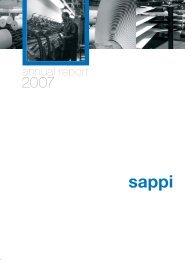2012 Integrated report - Sappi
2012 Integrated report - Sappi
2012 Integrated report - Sappi
You also want an ePaper? Increase the reach of your titles
YUMPU automatically turns print PDFs into web optimized ePapers that Google loves.
Chief financial officer’s <strong>report</strong> continued<br />
Section 5 – Balance sheet continued<br />
> A key objective for <strong>2012</strong> was the refinancing of the group’s<br />
most expensive debt, the US$300 million and €350 million<br />
2014 bonds. In June <strong>2012</strong>, we issued a new US$300 million<br />
seven-year bond and a US$400 million five-year bond issued<br />
at a coupon of 8.375% and 7.75% respectively.<br />
> The full proceeds of these new bonds were used to redeem<br />
the majority of the 2014 bonds. The remaining €31 million<br />
balance of the 2014 bonds are expected to be redeemed<br />
in quarter 1 of the 2013 financial year, using cash proceeds<br />
from the sale of the Biberist Mill.<br />
> The remaining balance of €9 million of the Oesterreichische<br />
Kontrollbank (OeKB) China facility was repaid in September<br />
<strong>2012</strong> after agreement was reached for the sale of the Jiangxi<br />
investment.<br />
> In August <strong>2012</strong>, a new €136 million five-year amortising loan<br />
was taken up for the purpose of funding the dissolving wood<br />
pulp conversion project at Cloquet. This syndicated loan is<br />
funded by the OeKB, an Austrian development bank, and<br />
syndicated to <strong>Sappi</strong> relationship banks. As in previous<br />
transactions, the OeKB provides the funding and the <strong>Sappi</strong><br />
credit risk is guaranteed to the OeKB by four Austrian<br />
relationship banks.<br />
> The early repayment of the 2014 bonds required the<br />
simultaneous unwinding of currency swaps attached to<br />
the bonds, resulting in a positive cash settlement of<br />
US$43 million as the movement of the US Dollar against the<br />
Euro was favourable since taking up the swaps in 2009.<br />
> The annual reduction in cash finance charges as a result of<br />
the above refinancing will be approximately US$30 million.<br />
The accelerated amortisations as a consequence of the 2014<br />
bond refinancing will reduce the income statement charge by<br />
a further amount of approximately US$15 million per annum.<br />
Following the refinancing, the normalised finance costs will<br />
improve to approximately US$160 million per annum.<br />
We believe the liquidity position is good and continues to improve,<br />
with our cash holdings exceeding our short term obligations<br />
by US$379 million at the <strong>2012</strong> year end. In addition, we have<br />
US$556 million unutilised committed facilities, including<br />
a revolving credit facility in Europe of US$450 million which<br />
provides further flexibility.<br />
Movement in net debt<br />
The movement of our net debt over fiscal <strong>2012</strong> is explained in the<br />
table below:<br />
US$ million<br />
Net debt at September 2011 2,100<br />
Net cash generated in <strong>2012</strong> (127)<br />
Currency translation impact (54)<br />
Fair value and other non-cash adjustments 17<br />
Cost of refinancing 2014 bonds 86<br />
Cash settlement of IRCS unwind related to 2014<br />
bond repayment (43)<br />
Net debt at September <strong>2012</strong> 1,979<br />
Debt funding structure<br />
The <strong>Sappi</strong> group principally takes up debt in two legal entities.<br />
<strong>Sappi</strong> Southern Africa (Pty) Limited issues debt in the local market<br />
for its own funding requirements and <strong>Sappi</strong> Papier Holding<br />
GmbH, which is our international holding company, issues debt<br />
in the international money and capital markets to fund our<br />
non-South African businesses. <strong>Sappi</strong> Papier Holding’s long term<br />
debt is supported by a <strong>Sappi</strong> Limited guarantee and the financial<br />
covenants on certain of its debt are based on the ratios of the<br />
consolidated <strong>Sappi</strong> Limited group. The covenants applicable to<br />
the debt of these two entities and their respective credit ratings<br />
are discussed below.<br />
The diagram below depicts our debt funding structure.<br />
These activities have materially improved the group’s debt maturity<br />
profile. Please refer to the group debt profile section below.<br />
Structure of net debt and liquidity<br />
The structure of our net debt at September <strong>2012</strong> and 2011 is<br />
summarised below:<br />
<strong>Sappi</strong> Limited guarantee*<br />
<strong>Sappi</strong> Limited<br />
US$ million <strong>2012</strong> 2011<br />
Long term debt 2,358 2,289<br />
Secured debt 1,424 1,426<br />
Unsecured debt 741 719<br />
Securitisation funding 380 368<br />
Less: Short term portion (187) (224)<br />
Net short term debt (cash) (379) (189)<br />
<strong>Sappi</strong> Southern<br />
Africa (SSA)<br />
<strong>Sappi</strong> Papier<br />
Holding (SPH)<br />
debt<br />
Non-South<br />
African debt<br />
Overdrafts and short term loans 79 226<br />
Short term portion of<br />
long term debt 187 224<br />
Less: Cash (645) (639)<br />
Net debt 1,979 2,100<br />
<strong>Sappi</strong><br />
Europe<br />
<strong>Sappi</strong><br />
North America<br />
<strong>Sappi</strong><br />
Trading<br />
* <strong>Sappi</strong> Limited provides guarantees for long term non-South African debt.<br />
62
















